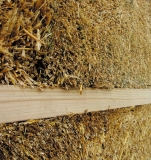Strawbale Hut or Eco House?

Since people got out of the caves and began to build their own dwellings, they used everything they could find in the surrounding nature for construction of their homes. Reed and wooden huts, stone houses – all of these dwellings were built without any problems if there were available natural materials. In the extreme case one could use a mixture of ordinary clay, earth, straw and sand. This technology is called the adobe wall. In addition, a later time these technologies began to combine – built-up wooden houses were often covered with a layer of clay (mud huts). As the result, the timber life circle was increased and additional insulation of the dwelling was done.
Wooden houses with proper waterproofing can stand for many decades. For example, in Siberia with its harsh continental climate, wooden houses made life of people more comfortable. In winter, inside these houses is warm, and in the summer it is cool. Houses made of brick or stone (as well as wooden ones with a small thickness of walls) in cold latitudes must be insulated.
The insulated house becomes more energy efficient – much less energy is spent on heating it. But in the course of time, all materials react differently to changes in temperature and humidity in the environment. And due to the fact that there is no keying action between the surfaces of the materials (adhesion), the cavities between the carrier material and the heater can form in the walls of the house. Thus, there are gaps that are blown and lead to cooling of the premises, and also become the loopholes for rodents and insects.
 Text by Slava Dushin
Text by Slava Dushin
Full content of this issue you can read here
The full version of the article can be read in our printed issue, also you can subscribe to the web-version of the magazine


